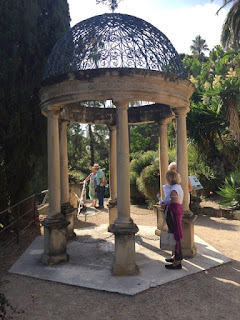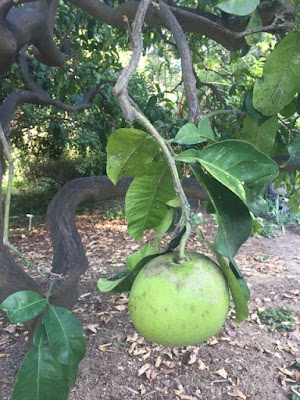After lunch it was off to the Hanbury Gardens in La Mortola. The property spans the whole of the Mortola Cape, in total 45 acres, the gardens occupy half of it. The rest is left to indigenous vegetation.
Gillian with a view of San Remo in the distance
After earning a fortune in trading in China, Thomas Hanbury purchased the land together with the ruins of a 11th palazzo built by the Lanteri family.
The Palazzo
The landscaping of the garden was in the main the work of Ludwig Winter recommended to Sir Thomas Hanbury by Charles Huber, a nursery man living in Hyeres.
Temple of the 4 Seasons, Dorothy Hanbury is buried beneath it.
Between 1925 and 1939, Sir Thomas's daughter-in-law, Dorothy Hanbury, made many changes to the garden.
The garden suffered in WW2 and was given to the Italian State in 1960, then in 1987 it was entrusted to the University of Genua.
The Hanbury family still owns a property on the site.
No matter what time of the year you visit, it is always impressive. Most of our group had not been there before and were absolutely amazed at the sizes of some of the Aloes, Agaves, Yuccas, Cacti and Succulents. Although Aloe and Agaves look alike, the difference can be felt in the spines on the leaves, Aloe's leaf margins are softer.
Agave with small Echinocactus in front
Betty
Agave victoriae-reginae
In the front: Agave attenuata
Dasylirion serratifolium, with razor sharp edges, unlike Agave's the plant does not die after flowering. (Mexico)
Euphorbia candelabra (from Somalia to South Africa)
After this very hot summer not much was in flower. We came across two orange flowering bulbs, never encountered before.
Haemanthus coccineus
Brunsvigia josephinae
Brunsvigia josephinae in different stages of development
Some shrubs that were interesting:
Hibiscus rosa sinensis
Hibiscus moscheutos
Salvia leucantha
Leucophyllum frutescens with Solanum rantonetii behind (in our area in a protected spot)
Ceratostigma plumbaginoides, does very well in our area, originally from W. China
Eriocephalus africanus (South Africa)
In the Japanese Garden there is lovely pond with turtles and goldfish, with a dragon fountain surrounded by foliage, Cyperuspapyrus and Calocasia esculenta leaves:
Cyperus papyrus in between the Calocasia esculenta with above the cave with the statue of the 'Slave'
Almost at the bottom of the walk there is a large area of ancient varieties of citrus fruit
Citrus maxima (Pummelo) can weigh up to 1.8 kg
Mermaid Fountain
Our thanks to Marie-France for taking the photos.

































